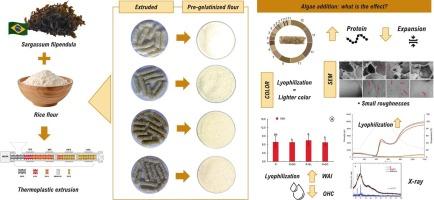海带马尾藻与米粉在热塑性挤压即食食品生产中的相互作用
IF 4.5
2区 生物学
Q1 BIOTECHNOLOGY & APPLIED MICROBIOLOGY
Algal Research-Biomass Biofuels and Bioproducts
Pub Date : 2025-09-05
DOI:10.1016/j.algal.2025.104289
引用次数: 0
摘要
本研究采用烘干面粉(SD)、冻干面粉(SL)和商品面粉(SC)三种加工方法,对1.5%脱水马尾藻面粉(S)部分替代米粉(R)的效果进行了评价。制备的配方包括对照(R)和3个替代配方(R + SD, R + SL, R + SC),在双螺杆挤出机中进行加工,四个区域的温度分别为70℃,90℃,120℃和115℃,螺杆转速为200 rpm,水分为15%。采用Scott-Knott检验比较(p≤0.05)。R的替代影响了挤压过程中的扭矩和比机械效率(SME)。R + SD、R + SL和R + SC配方的挤出物硬度较高,而孔隙率无显著差异。微观结构分析表明,纯大米挤压物(R)表面更为均匀,而R + SD、R + SL和R + SC样品则显示出明显的粗糙区域。x射线衍射证实了V型淀粉的存在,并表明挤压过程影响了所分析材料的结构组织。所有预糊化面粉均形成冷糊状,其中R + SL配方对DPPH自由基的清除能力最高,显示出抗氧化活性潜力。在颜色分析中,通过成像,可以观察到只含有大米的挤出物和预糊化面粉是白色的,而含有海藻的配方则呈现褐色色调,在样品中分布着黑点。结果表明,海藻的组成、产地和干燥方法的不同会影响大米挤出物的理化性质。本文章由计算机程序翻译,如有差异,请以英文原文为准。

Interaction between the seaweed Sargassum filipendula and rice flour in the production of ready-to-eat foods by thermoplastic extrusion
This study aimed to evaluate the effects of partially substituting rice flour (R) with 1.5 % dehydrated Sargassum filipendula (S) flours, using three processing methods: oven-dried flour (SD), freeze-dried flour (SL), and commercial flour (SC). The formulations prepared included a control (R) and three with substitutions (R + SD, R + SL, R + SC), which were processed in a twin-screw extruder with the temperatures of the four zones set at 70 °C, 90 °C, 120 °C, and 115 °C, a screw speed of 200 rpm, and 15 % moisture. The properties were comparatively using the Scott-Knott Test (p ≤ 0.05). The substitution of R affected the torque and specific mechanical efficiency (SME) during the extrusion process. The hardness of the extrudates was higher in the R + SD, R + SL, and R + SC formulations, while porosity did not show significant differences. Microstructure analysis revealed more homogeneous surfaces for the rice-only extrudates (R), while the R + SD, R + SL, and R + SC samples showed visible areas of roughness. X-ray diffraction demonstrated the presence of type V starch and showed that the extrusion process influenced the structural organization of the materials analyzed. All pre-gelatinized flours formed cold paste, with the R + SL formulation showing the highest capacity for DPPH radical scavenging, indicating antioxidant activity potential. In the color analysis, through imaging, it was observed that extrudates and pre-gelatinized flours containing only rice were white, while the formulations with seaweed exhibited brownish tones with dark spots distributed across the sample. The results indicate that differences in composition, origin, and drying methods of seaweed influence the physicochemical properties of the rice extrudates.
求助全文
通过发布文献求助,成功后即可免费获取论文全文。
去求助
来源期刊

Algal Research-Biomass Biofuels and Bioproducts
BIOTECHNOLOGY & APPLIED MICROBIOLOGY-
CiteScore
9.40
自引率
7.80%
发文量
332
期刊介绍:
Algal Research is an international phycology journal covering all areas of emerging technologies in algae biology, biomass production, cultivation, harvesting, extraction, bioproducts, biorefinery, engineering, and econometrics. Algae is defined to include cyanobacteria, microalgae, and protists and symbionts of interest in biotechnology. The journal publishes original research and reviews for the following scope: algal biology, including but not exclusive to: phylogeny, biodiversity, molecular traits, metabolic regulation, and genetic engineering, algal cultivation, e.g. phototrophic systems, heterotrophic systems, and mixotrophic systems, algal harvesting and extraction systems, biotechnology to convert algal biomass and components into biofuels and bioproducts, e.g., nutraceuticals, pharmaceuticals, animal feed, plastics, etc. algal products and their economic assessment
 求助内容:
求助内容: 应助结果提醒方式:
应助结果提醒方式:


